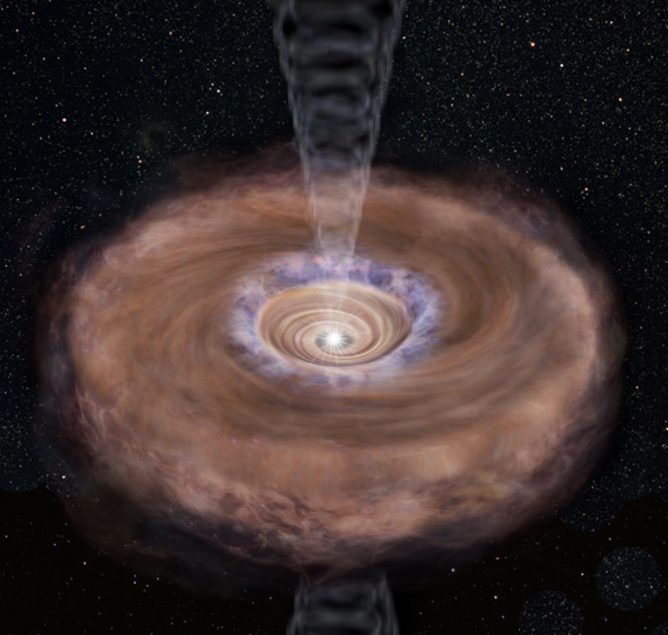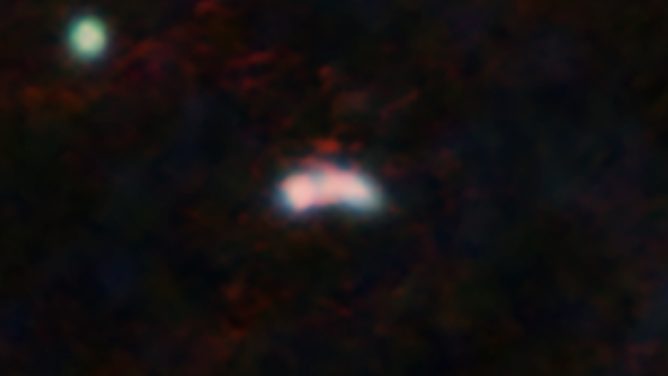One of the big puzzles in astrophysics is how stars like the sun manage to form from collapsing molecular clouds in star-forming regions of the universe. The puzzle is known technically as the angular momentum problem in stellar formation. The problem essentially is that the gas in the star-forming cloud have some rotation, which gives each element of the gas an amount of angular momentum. As they collapse inward, eventually they reach a state where the gravitational pull of the nascent star is balanced by the centrifugal force, so that they will no longer collapse inward of a certain radius unless they can shed some of the angular momentum. This point is known as the centrifugal barrier.
Now, using measurements taken by radio antennas, a group led by Nami Sakai of the RIKEN Star and Planet Formation Laboratory has found clues as to how the gas in the cloud can find their way to the forming star. To gain a better understanding of the process, Sakai and her group turned to the ALMA observatory, a network of 66 radio dishes located high in the Atacama Desert of northern Chile. The dishes are connected together in a carefully choreographed configuration so that they can provide images on radio emissions from protostellar regions around the sky.
The group chose to observe a protostar designated as L1527, located in a nearby star-forming region known as the Taurus Molecular Cloud. The protostar, located about 450 light years away, has a spinning protoplanetary disk, almost edge-on to our view, embedded in a large envelope of molecules and dust.
Previously, Sakai had discovered, from observations of molecules around the same protostar, that unlike the commonly held hypothesis, the transition from envelope to the inner disk–which later forms into planets–was not smooth but very complex. “As we looked at the observational data,” says Sakai, “we realized that the region near the centrifugal barrier–where particles can no longer infall–is quite complex, and we realized that analyzing the movements in this transition zone could be crucial for understanding how the envelope collapses. Our observations showed that there is a broadening of the envelope at that place, indicating something like a ‘traffic jam’ in the region just outside the centrifugal barrier, where the gas heats up as the result of a shock wave. It became clear from the observations that a significant part of the angular momentum is lost by gas being cast in the vertical direction from the flattened protoplanetary disk that formed around the protostar.”
Figure 1: Integrated intensity distribution of CCH, superposed on the 0.8 mm dust continuum map. The infalling rotating envelope traced by CCH is broadened inward of the radius of about 150 au.
Credit: Sakai et al. (RIKEN)
Figure 2: Artist’s impression of L1527
Credit: RIKEN
This behavior accorded well with calculations the group had done using a purely ballistic model, where the particles behave like simple projectiles that do not need to be influenced by magnetic or other forces.
According to Sakai, “We plan to continue to use observations from the powerful ALMA array to further refine our understanding of the dynamics of stellar formation and fully explain how matter collapses onto the forming star. This work could also help us to better understand the evolution of our own solar system.”
Paper and Research team
These observation results were published as Sakai et al. “Vertical Structure of the Transition Zone from Infalling Rotating Envelope to Disk in the Class 0 Protostar, IRAS04368+2557” in the Monthly Notices of the Royal Astronomical Society in February 2017.
The research team members are:
Nami Sakai (The Institute of Physical and Chemical Research (RIKEN)), Yoko Oya (The University of Tokyo), Aya E. Higuchi (RIKEN), Yuri Aikawa (University of Tsukuba), Tomoyuki Hanawa (Chiba University), Cecilia Ceccarelli (Laboratoire d’Astrophysique de Grenoble), B. Lefloch (Laboratoire d’Astrophysique de Grenoble), Ana López-Sepulcre (The University of Tokyo / Institut de Radioastronomie Millimétrique), Yoshimasa Watanabe (The University of Tokyo), Takeshi Sakai (The University of Electro-Communications), Tomoya Hirota (National Astronomical Observatory of Japan), Emmanuel Caux (Universite de Toulouse), Charlotte Vastel (Universite de Toulouse), Claudine Kahane (Laboratoire d’Astrophysique de Grenoble), Satoshi Yamamoto (The University of Tokyo)
This research was supported by a Grant-in-Aid from the Japan Society for the Promotion of Science and the Ministry of Education, Culture, Sports, Science and Technology, Japan (No. 25400223, 25108005, 16H03964).
ALMA
ALMA construction and operations are led by ESO on behalf of its Member States; by the National Radio Astronomy Observatory (NRAO), managed by Associated Universities, Inc. (AUI), on behalf of North America; and by the National Astronomical Observatory of Japan (NAOJ) on behalf of East Asia. The Joint ALMA Observatory (JAO) provides the unified leadership and management of the construction, commissioning and operation of ALMA.










